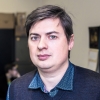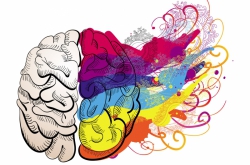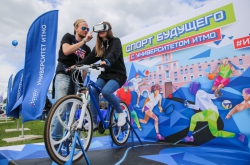The International Animation Assembly brings together animation experts from various universities and companies, giving them an opportunity to discuss the latest developments and achievements in the field of animation. The event is organized by the St. Petersburg Stieglitz State Academy of Art and Design and involves experts from the Academy’s many partner universities.
ITMO University participated in the Assembly’s science section while its staff operated a VR demo area where guests could use HTC Vive and Samsung Gear VR headsets to try out projects by Bachelor’s students of the Graphical Technologies Center. Those who dared to put on a headset found themselves in a virtual world inspired by Hieronymus Bosch’s triptych “The Garden of Earthly Delights”.

Another project was developed by ITMO University students together with the staff of the ROSPHOTO museum and exhibition space. The students chose images from the museum’s archive, analyzed the emotions they elicited in observers, and then created a program that shows which parts of the brain are activated by each particular emotion and image.
Head of ITMO’s Educational Center of Graphical Technologies and the Center for Usability and Mixed Reality, Artem Smolin, has no doubts about the value of this synergy of creativity and tech.
“ITMO is an interdisciplinary university, and one of our main development vectors are interdisciplinary projects that combine IT with culture, arts and entertainment. We work on interface design technologies, especially in the fields of VR and AR, and find new applications for them. And, of course, we’re happy to work with artists and inspire them,” he says.

Hi-tech animation
The International Animation Assembly consists of a series of roundtable discussions, student competitions and workshops. Among them, for instance, were the tutors from Skills Up School, a school of computer graphics and drawing. They shared insights about working in the game industry, changing up styles in digital painting, and combining 2D and 3D. Rinat Khabirov, a digital artist and tutor, doesn’t want to be complacent and seeks out new creative tools.
“I’m excited about the future and the new tools it will bring. The 3D software we use today is the future we dreamt of just ten years ago. I can do studio-grade designs on my home PC. Everything is possible,” he explains
Rinat admits that VR still remains a bit of a mystery to him, but he recognizes the opportunities it provides to artists.

“It lets us better involve viewers in our work. They stop being an observer and become a participant within the very space of the artwork. In film, we only see the director’s view of the events; with VR, we take a step in the other direction when we combine arts and knowledge in one virtual reality. It’s an interactive story. Of course, one artist can’t do it all. It used to be that you’d draw a picture and leave it to others to interpret it. Artists of the future will need to work with directors, sound designers and engineers in order to ensure maximum immersion. Perhaps VR technologies will become our main source of entertainment. I cannot claim to know how it would come about, but I believe that we, artists, will have a direct say in deciding how that new world is going to work,” he concluded.
Rundown of character artist Rinat Khabirov’s lecture “Mix Fight in CG. Combined 2D, 3D and traditional graphics”:
Many have heard of MMA or Mix Fight, a combination of various martial arts schools and techniques. The Mix Fight principle can apply to graphic design, too, when designers combine different software to achieve an optimal result. Illustrator, Procreate, Crita, 3D Max. Mix them up and you’ll get something much more effective and relevant to your objectives. But choose wisely, and only work with the software you’re good at.

What is the working process of a graphic designer? First, you collect the references that will serve as a starting point. Other artists’ works, museum photos, architectural details, even bits of trash you see outside. Try to interpret the forms. I once used a picture of a canary bird as the basis for a drawing of Scheherazade. Another time, I used a fallen leaf as a reference for a scarf.
After this, you outline the graphical elements that will tie together the entire composition. You need to justify your choices logically and from a cultural point of view. When I did a drawing for a character contest based on Alexander Pushkin’s “Ruslan and Lyudmila”, I picked the color white, gold, and Russian folk motifs such as carpets, patchwork, and traditional ornaments. Then I used all these elements in each character’s design to establish a common thread.

Then you start to look for a graphical solution, i.e. the drawing itself. In essence, you’re brainstorming lines and silhouettes. It’s important not to go into detail, but rather work on the general outline; you need an “outer shell” to give you a hint at what character lies within. I prefer to use an A5 notepad and a pen. Use the margins to jot down which references you’ll need to find later.
The final, and the longest, part is perfecting the sketch using graphical software. I usually start with the lines and large spots in Photoshop, then finish it off in 3D software like 3D Max or Zbrush, where I combine two images in order to give the picture depth. The process involves a bit of back-and-forth: first, you sculpt the textures in 3D, and then you go back to Photoshop for details.
Graphical software expands our limits as artists. The most important thing is not to stay in your comfort zone. That’s boring and won’t get you anywhere.






